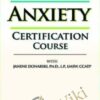$439.99 Original price was: $439.99.$171.00Current price is: $171.00.
But abuse can be difficult to detect after the physical signs of violence have faded. What defines abuse and how does one properly assess for it? And when it’s brought into the light, domestic violence can raise professional dilemmas that leave you caught between responsibilities surrounding confidentiality, autonomy, and your wider responsibilities to protect victims.
 Purchase this course you will earn 171 Points worth of $17.10
Purchase this course you will earn 171 Points worth of $17.10Elevate your skills with the Domestic and Intimate Partner Violence in Maine: Identification, Documentation, Reporting and Trauma-Informed Responses – Katelyn Baxter-Musser course, available for just $439.99 Original price was: $439.99.$171.00Current price is: $171.00. on Utralist.com! Browse our curated selection of over 60,000 downloadable digital courses across diverse Uncategorized. Benefit from expert-led, self-paced instruction and save over 80%. Start learning smarter today!
Regardless of your area of focus, you’re likely to encounter Domestic and Intimate Partner Violence at some point in your practice.
But abuse can be difficult to detect after the physical signs of violence have faded. What defines abuse and how does one properly assess for it? And when it’s brought into the light, domestic violence can raise professional dilemmas that leave you caught between responsibilities surrounding confidentiality, autonomy, and your wider responsibilities to protect victims.
It’s a complicated situation that can leave you unsure of how to proceed and troubled knowing that failure to recognize and properly respond to domestic violence can have dire consequences.
Starting on January 1st, 2020 social workers and counselors in Maine are required to have completed 12 CE hours of training in domestic or intimate partner violence for renewal of their license or initial licensure.
This recording is your chance to complete all 12 required hours and get the tools and guidance you need to recognize the red flags of domestic and intimate partner violence, properly report and document abuse, and effectively respond and intervene in a trauma-sensitive manner.
Whether you’re a social worker, counselor, psychologist, marriage and family therapist, nurse, or anyone in the helping professions, this program will serve as an indispensable guide for how you can improve outcomes for those impacted by domestic and intimate partner violence.
- Employ screening techniques to identify the signs of domestic violence (DV) and intimate partner violence (IPV).
- Establish how evidence-based screenings and assessments can help clinicians determine level of risk and lethality to effectively intervene.
- Ensure proper reporting and documentation when working with clients facing violence in their relationships or homes.
- Characterize the dynamics of domestic violence/intimate partner violence and control tactics used by the perpetrator.
- Evaluate the types of domestic abuse including physical violence, sexual violence, threats and intimidation.
- Connect your clients to domestic violence related services through community resources and appropriate referrals.
- Communicate three barriers that keep people from leaving abusive relationships.
- Characterize how an understanding of cultural factors can help to ensure a competent response to abuse.
- Specify two intervention strategies clinicians can use to enhance treatment of women, men and children who’ve been exposed to domestic violence.
- Develop safety plans with clients to help them leave an abusive or violent home.
- Assess same-gender abuse dynamics and identify aspects of LGBTQ intimate partner violence that may make victims less likely to seek help.
- Employ trauma-informed treatment techniques for survivors of abuse, violence and oppression.
Victims, Perpetrators and Dynamics of Domestic and Intimate Partner Violence
- Myths about domestic and intimate partner violence
- Types of domestic violence
- Dynamics of power, manipulation and control
- Characteristics of perpetrators
- Substance abuse and violence
- Same gender abuse dynamics
Recognize the Red Flags of Violence: What All Clinicians Need to Know
- Screening and assessment techniques
- Identify immediate danger
- Injuries and other indicators
- Tools to assess for safety, risk and lethality
- Checklists and advocacy resources
- Technology and domestic/intimate partner violence
Non-Physical Abuse and Psychological Violence
- Who’s at risk?
- Warning signs and symptoms
- Emotional manipulation
- Yelling and intimidation
- Inappropriate sexual pressure
Reporting Requirements and Documentation Guidelines
- Privacy and confidentiality
- Who is required to report and when?
- Standards for making a report
- Domestic violence contacts and hotlines
- Proper documentation and confidentiality strategies
- When and how to refer to agencies
- Community resources
- Liability issues for failing to report
Crisis Intervention, Safety Plans and Available Services
- Safety plans while living with abusive partners
- Safety planning for children
- Emotional safety planning
- Barriers to leaving
- Plans for leaving and after leaving
- Restraining orders/protective orders
Culturally Competent Responses to Abuse
- Recognizing your own biases
- How survivors interpret domestic violence in their culture
- Adapting danger assessments for underserved populations
- Working with LGBTQ survivors
Trauma Informed Interventions: Transition Clients from Surviving to Thriving
- Assess for PTSD, anxiety, trauma and other mental health issues
- Understand the multilayered impact of DV/IPV
- Processing shame, anger and guilt
- Working with children exposed to domestic violence
- Relaxation skills and guided imagery for anxiety
Get Domestic and Intimate Partner Violence in Maine: Identification, Documentation, Reporting and Trauma-Informed Responses – Katelyn Baxter-Musser, Only Price $175
Tag: Domestic and Intimate Partner Violence in Maine: Identification, Documentation, Reporting and Trauma-Informed Responses – Katelyn Baxter-Musser Review. Domestic and Intimate Partner Violence in Maine: Identification, Documentation, Reporting and Trauma-Informed Responses – Katelyn Baxter-Musser download. Domestic and Intimate Partner Violence in Maine: Identification, Documentation, Reporting and Trauma-Informed Responses – Katelyn Baxter-Musser discount.
Cultivate continuous growth with the Domestic and Intimate Partner Violence in Maine: Identification, Documentation, Reporting and Trauma-Informed Responses – Katelyn Baxter-Musser course at Utralist.com! Unlock lifetime access to premium digital content, meticulously designed for both career advancement and personal enrichment.
- Lifetime Access: Enjoy limitless access to your purchased courses.
- Exceptional Value: Benefit from savings up to 80% on high-quality courses.
- Secure Transactions: Your payments are always safe and protected.
- Practical Application: Gain real-world skills applicable to your goals.
- Instant Accessibility: Begin your learning journey immediately after buying.
- Device Compatible: Access your courses seamlessly on any device.
Transform your potential with Utralist.com!
Related products
= 65 Points
= 85 Points
= 72 Points
Uncategorized
Legal Risks in Nursing Documentation – Use Extreme Caution When Skimming the Facts – Rosale Lobo
= 40 Points
Uncategorized
= 35 Points
= 84 Points
Uncategorized
= 85 Points
= 94 Points





